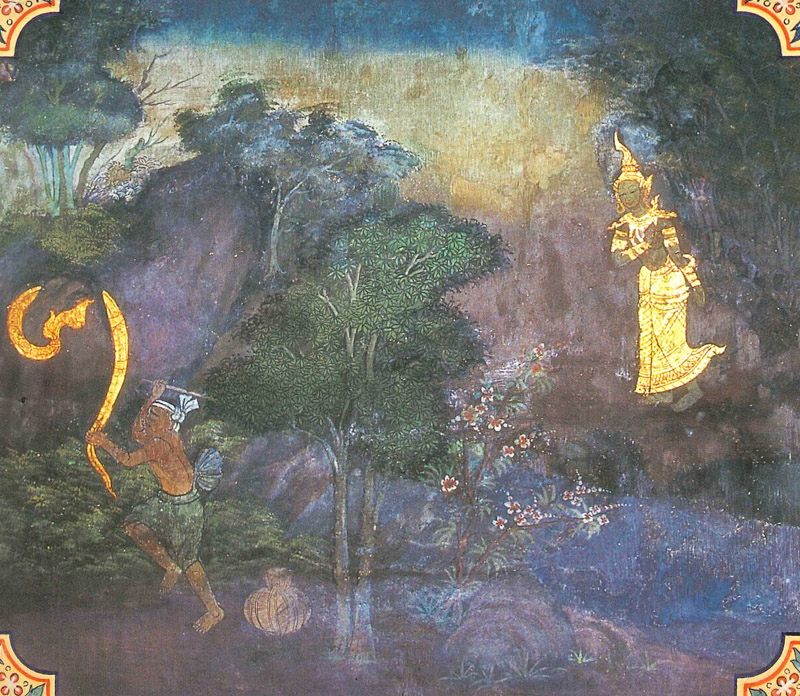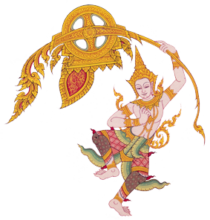
The Bodhisatta was once a man from a poor family and then a naga king in back-to-back lives. Two human kings were constantly at war, repeatedly gaining and losing control of their rival’s territory. One day, after suffering defeat in a battle, one of the kings fled with enemy warriors in pursuit. He came to a flooded river and plunged in, preferring to risk drowning instead of being captured.
A naga king lived in this river, and when he saw the magnificent king crossing it, he felt fondness for him and brought him into his jeweled palace. When the king explained why he jumped into the river, the naga king promised to use his magic powers to make him ruler of both kingdoms. After enjoying the naga king’s hospitality for a week, the king went out and slew his rival, becoming the undisputed leader. In gratitude, the king built a new jeweled pavilion on the riverbank every year, and the naga king came with a large entourage to receive tribute from his friend. When the Bodhisatta saw the nagas’ magnificence at one of these annual festivals, he yearned for rebirth in the naga world for his next life. And because he lived righteously, his wish came true, and he was reborn as a naga king.
The Bodhisatta ruled in great opulence, with naga maidens pampering him at all times. But he was not satisfied with the naga realm’s grandeur, and he wanted his next life to be as a human again. He tried to keep the holy-day vows and live a moral life, but because of the myriad temptations always around him, he frequently failed. So, despite the danger of being captured and killed, he began to spend the holy days in the human realm atop an anthill, where he would not be distracted. He told his worried queen the water in their lucky pond would turn murky if he got assaulted, disappear if he got carried off by a garuda, and become blood red if he got caught by a snake charmer.
People from the nearby village began to worship the naga, and they built a pavilion over the anthill. When a man who knew a magic spell that could control all the senses was traveling home and passed by the Bodhisatta, he decided to capture him to make some money working as a snake charmer. The man ate an herb and recited the spell, and the Bodhisatta felt as if his head had been split by a sword and blisters rose on his skin. Despite the pain, the Bodhisatta resolved to not get angry or resist because he did not want to stray from the path of righteousness. (Had he sprayed poison out of his nostrils, the snake charmer’s body would have shattered and scattered like a fistful of chaff.) Instead, he closed his eyes, drew his head into his hood, and quietly endured the pain. The snake charmer pulled the Bodhisatta’s tail to stretch him out full length on the ground, squeezed his body to make him weak, broke his teeth, and stuffed his bloody body into a basket.
The brahmin took the Bodhisatta to the nearby village and made him perform: changing color, size, and shape, and dancing so fast he appeared to have thousands of heads. The crowd was amazed and gave the snake charmer more than a thousand coins plus various other gifts. The snake charmer had originally planned to set the Bodhisatta free after earning one thousand coins, but this initial performance made him greedy and he set out to get rich performing for kings and courtiers. He bought a carriage and a wagon and did shows in every town he passed for a month until he reached the capital city, where he was invited to perform for the king.
On the day of the Bodhisatta’s palace performance, his queen wondered why he had not been home for so long and went to check the lucky pond. Finding the water red, she took human form and rushed to his anthill, and there she saw the blood where the Bodhisatta had been tortured. In the village she learned what had happened and went to the city, arriving in the palace courtyard while the show for the king was underway. While he danced, the Bodhisatta saw his tearful wife floating in the air above the adoring crowd, and he crawled into his basket in shame.
The show interrupted, the king noticed the naga queen and asked why she was angry. She told the king what had been done to the Bodhisatta, and why he had not killed his captor. She begged for his release, and the righteous king offered to pay the snake charmer with gold, jewels, cattle, wives, and other riches. But he refused payment and set the Bodhisatta free unconditionally.
The Bodhisatta took human form and, with his queen, showed respect to the king. And, to erase his doubts over the truth of his tale, the Bodhisatta invited the king to visit the naga realm. The king and his entourage entered on a gloriously adorned road and saw the city wall made of the seven precious jewels and towers made of gold; inside were many palaces. The Bodhisatta’s ornate palace was scented with perfumes, shaded by trees, and filled with the sound of celestial harps. For a week, the visitors enjoyed divine food and drink and all manner of pleasures.
When it was time for the king to return home, the Bodhisatta told him and his courtiers to take as much treasure as they wanted, and they rode home with hundreds of carts laden with gold, silver, pearls, and coral.
In the Lifetime of the Buddha
One time the Buddha praised some lay followers for observing the holy-day vows and told them this story so they knew that, even when he lived the glorious life of a naga king, he faithfully observed the holy days.
The snake charmer, the naga queen, and the king who befriended the Bodhisatta were earlier births of Devadatta, a disciple of the Buddha who became his nemesis; the Buddha’s wife; and Sariputta, one of the Buddha’s top disciples.
